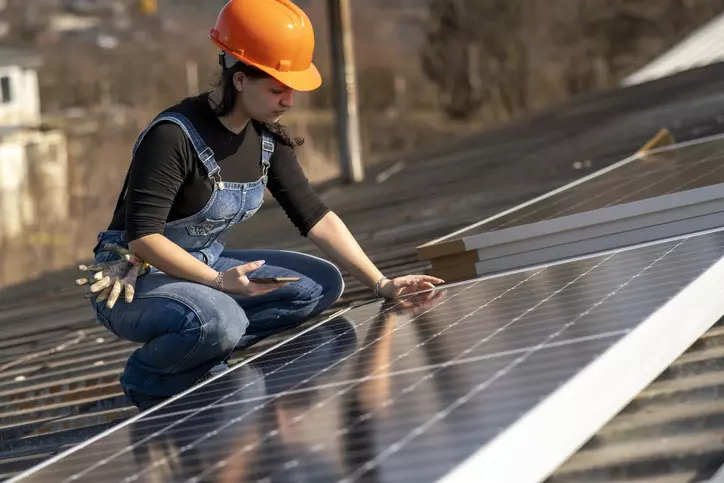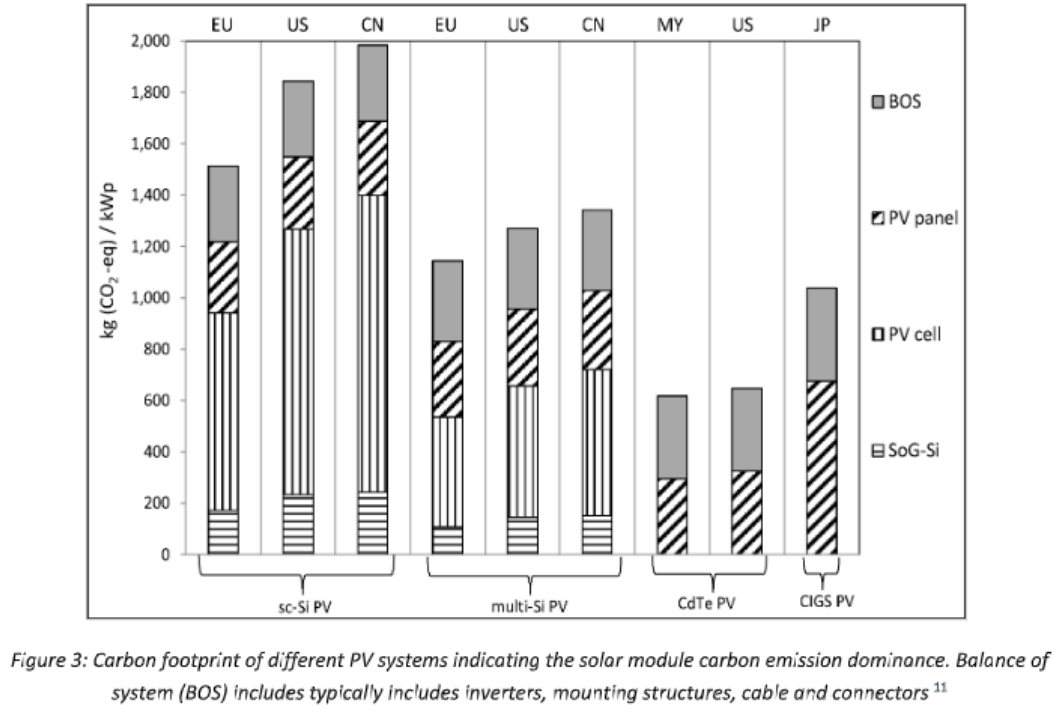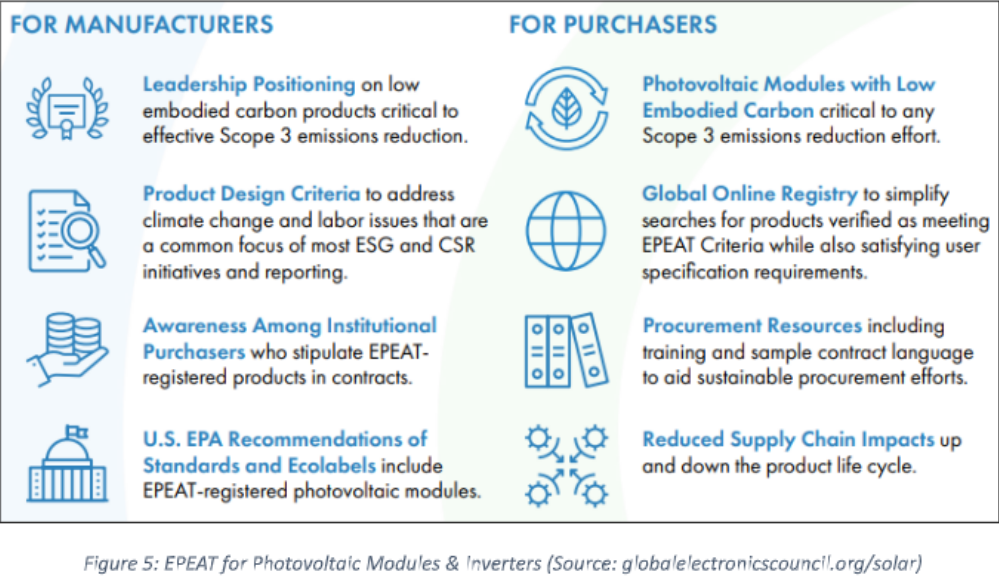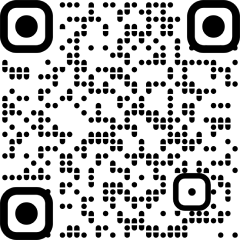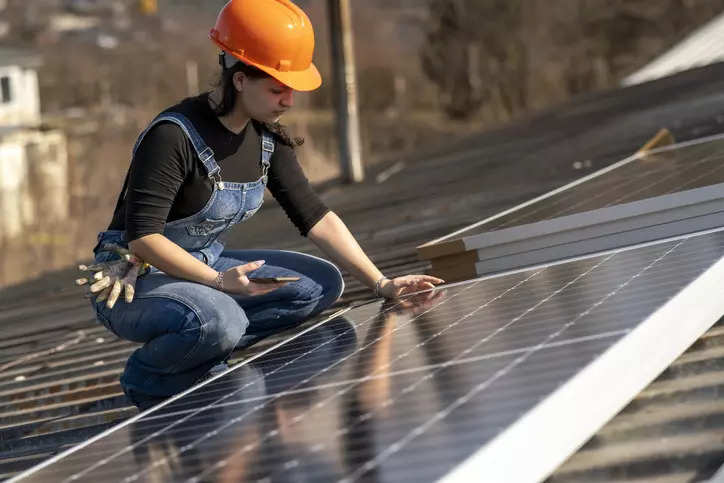
New Delhi: The global solar PV market has been growing rapidly to meet the increasing demand for green power and proving to be a cost-effective climate change mitigation solution in most parts of the world. The global cumulative installed capacity passed the 1 TW mark in 2022, with at least 240 GW of PV systems commissioned in the world last year, with 23 countries installing more than 1 GW [1].
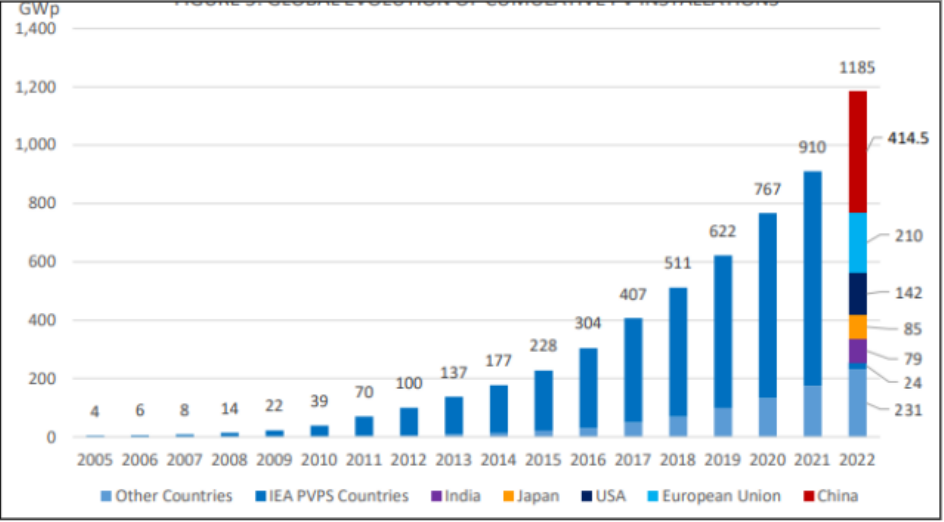
With estimates indicating tripling of annual solar PV additions by 2030 globally [2], there are conversations ongoing regarding the embodied carbon related to the manufacturing of solar PV modules. There are no direct emissions from the solar PV module operations, however the life cycle emissions factors for electricity generation according to NREL from solar PV is 43g CO2e/kWh in comparison to 1001 g CO2e/kWh for coal and 486 g CO2e/kWh in case of natural gas.
Beginning from the electricity source, upstream raw materials, the manufacturing and end of life emissions all contribute to the overall impact. The upstream greenhouse gas emissions of a solar PV power plant, also known as “embodied carbon,” represent nearly 60-70 per cent of the total life cycle footprint of the solar modules (Fig 2) [3]. Life cycle assessments estimate that PV modules made with energy from high carbon resources can have nearly twice the embodied carbon as modules produced with lower carbon resources [4]. The use of materials with lower embodied carbon and energy efficient manufacturing process in PV modules can reduce the life cycle carbon footprint of solar systems by 40 per cent or more [5].

Several developed countries are beginning to put in tender criteria mandating full disclosure on the carbon footprint of the PV modules. France has led the way since 2016 incorporating two pathways of LCA estimates with simplified methodology to specify the embodied carbon in the modules. Korea, Italy and Norway are following suit through the international product category rules (PCR) for the entire photovoltaic module value chain [6]. The EU is assessing mandating disclosure options of PV module carbon footprint in the EU Eco Design, Energy and Eco Labelling [7]. For the US FAR (Federal Acquisition Regulation) requires that 95 per cent of all electronic product acquisitions be EPEAT-registered products [8]. All of these are market indicators for the shift towards low embodied solar materials.Solar modules, frames, mounting equipment, connectors, invertors make up the main components of the solar photovoltaic systems of which module manufacturing produces the largest emissions (Fig 3).
The dominant technology in the market is crystalline silicon modules. As per the Life Cycle Inventories and Life Cycle Assessments of Photovoltaic Systems [9], published by the International Energy Agency (IEA) Photovoltaic Power Systems Program Task 12 [10] the below mentioned processes are the most important elements in the production of crystalline-Si modules. The life cycle global warming potential of crystalline silicon module is largely determined by the solar grade silicon & ingot production, due to the energy intensity of the process and the respective supply chain of electricity [11].
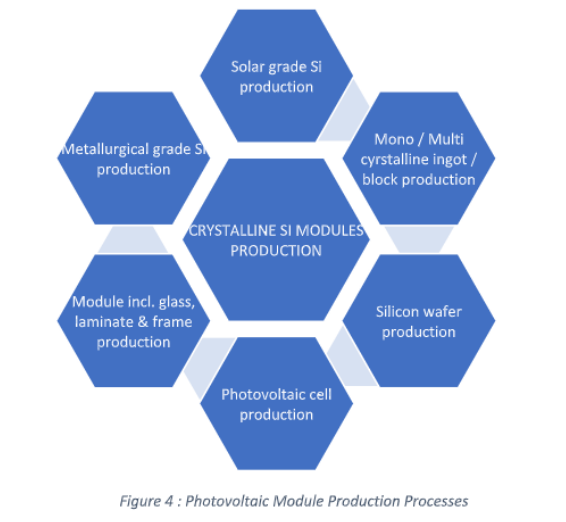
Based on the above impact, gradually the demand for sustainable PV modules would increase. The EPEAT Ecolabel [12] based on NSF 457 standards [13] have been developed globally. EPEAT is the leading global Type 1 ecolabel for electronics managed by the Global Electronics Council (GEC) which assists government agencies, private sector, educational institutions, & other organizations to find and procure technology products that meet rigorous sustainability criteria. This EPEAT criteria for modules & inverters help both the manufacturers & the buyers make a conscious decision on a product which not only have a reduced environmental impact but also includes the impact of technology on human & labour rights.
To be awarded the EPEAT (Electronic Product Environmental Assessment Tool) ecolabel, PV module manufacturers must conform to these ULCS Criteria and the EPEAT Criteria in NSF 457 – Sustainability Leadership Standard for Photovoltaic Modules and Photovoltaic Inverters [15]. EPEAT is a tiered ecolabel designed to recognize the top 25-30 per cent of the market. EPEAT Criteria are identified as either Required or Optional. Required Criteria must be met for a product to become EPEAT- registered (Bronze). Depending on the number of Optional Criteria met, a product may achieve an EPEAT rating of Silver or Gold. Products that meet EPEAT Criteria are identified in the public facing website called the EPEAT Registry.
With reference to Fig. 3 a study conducted on the Global Warming potential (GWP) for Single crystalline & multi crystalline Si was found in the range of 1500 – 2000 kgCO2-eq/kWp & 1100–1300 kgCO2-eq/kWp respectively. The EPEAT classification is divided into two categories: Low Carbon Solar Modules (required) & the Ultra Low Carbon Solar Modules (optional). The qualification criteria for the ‘Low Carbon Solar Module’ classification, a maximum of 630 kgCO2-eq/kWp is permitted from the manufacturing process. For the more climate-ambitious ‘Ultra Low Carbon Solar Modules’ classification the limit for the embodied carbon is 400 kgCO2-eq/kWp.
This new global certification by the non-profit organization Global Electronics Council, with funding from the Ultra Low-Carbon Solar Alliance (ULCSA) is a crucial resource for procurers, installers, retailers and other stakeholders who are committed to reduce the carbon footprint & promote a more sustainable solar PV industry. As the world moves toward an energy transition, such standards will gain increasing importance. It is crucial for manufacturers in India and other developing countries to be aware of the global trends and strive to de-carbonize their supply chains to support India’s goal of becoming a major solar exporter.
[This piece was written by Dwaipayan Chakraborty, MTech in Renewable Energy Engineering & Management from TERI SAS and is currently with International Solar Alliance (ISA)]
References:
1. Snapshot of Global PV Markets – 2023 (iea-pvps.org)
2. DNV-GL, Energy Transition Outlook 2020, https://eto.dnv.com/2020/index.html
3. Energy Laboratory (2012). “Life Cycle Greenhouse Gas Emissions from Solar Photovoltaics”. NREL/FS6A20-56487. November 2012
4. Fthenakis, V., und M. Raugei (2017). “Environmental life-cycle assessment of photovoltaic systems“, 2017, 209–32. https://doi.org/10.1016/B978-1-78242-336-2.00007-0 ; Leccisi, Enrica, Marco Raugei, und Vasilis Fthenakis (2016). “The Energy and Environmental Performance of GroundMounted Photovoltaic Systems—A Timely Update“. Energies 9, Nr. 8 (8. August 2016): 622. https://doi.org/10.3390/en9080622 ; Louwen, Atse, Ruud E.I. Schropp, Wilfried G.J.H.M. van Sark, und André P.C. Faaij. “Geospatial Analysis of the Energy Yield and Environmental Footprint of Different Photovoltaic Module Technologies“. Solar Energy 155 (Oktober 2017): 1339–53. https://doi.org/10.1016/j.solener.2017.07.056
5. Dajun Yue, Fengqi You and Seth B.Darling (2014). “Domestic and overseas manufacturing scenarios of silicon-based photovoltaics: Life cycle energy and environmental comparative analysis.” Argonne National Laboratory and Northwestern University. Solar Energy, Volume 107, September 2014, Pages 380.
6. The Norwegian EPD Foundation (2020). “PCR – Part B for photovoltaic modules used in the building and construction industry, including production of cell, wafer, ingot block and solar grade silicon”. Product Category Rules. EN 15804: NPCR 029 Version 1.0. 11 June 2020 ; EPD Italy. “PCR for PV Module”. EPDItaly 014 – rel. 1. 03 February 2020. Retrieved from: https://www.epditaly.it/en/pcr_/pcr-for-pv-module-epditaly-014/.
7. 9 Dodd, N. and Espinosa Martinez, M.D.L.N., Solar photovoltaic modules, inverters and systems: options and feasibility of EU Ecolabel and Green Public Procurement criteria, Preliminary report, EUR 30474 EN, Publications Office of the European Union, Luxembourg, 2021, ISBN 978-92-76-26819-2 (online), doi:10.2760/29743 (online), JRC122430. Retrieved from: https://ec.europa.eu/jrc/en/publication/ JRC Publications Repository – Solar photovoltaic modules, inverters and systems: options and feasibility of EU Ecolabel and Green Public Procurement criteria, Preliminary report (europa.eu);
8 Federal Acquisition Regulation (2021). “Part 23 – Environment, Energy and Water Efficiency, Renewable Energy Technologies, Occupational Safety, and Drug-Free Workplace”. FAC Number/Effective Date: 2021-03/2-16-2021- Download Entire FAR. Retrieved from: https://www.acquisition.gov/far/part-23;
9 R. Frischknecht, P. Stolz, L. Krebs, M. de Wild-Scholten, P. Sinha, V. Fthenakis, H. C. Kim, M. Raugei, M. Stucki, 2020, “Life Cycle Inventories and Life Cycle Assessment of Photovoltaic Systems”, International Energy Agency (IEA) PVPS Task 12, Report T12-19:2020
10 The goal of Task 12 is to foster international collaboration and knowledge creation in PV environmental sustainability and safety, as crucial elements for the sustainable growth of PV as a major contributor to global energy supply and emission reductions of the member countries and the world
11 Leccisi, Enrica, Marco Raugei, und Vasilis Fthenakis (2016). “The Energy and Environmental Performance of GroundMounted Photovoltaic Systems—A Timely Update“. Energies 9, Nr. 8 (8. August 2016): 622. https://doi.org/10.3390/en9080622
12 EPEAT Registry
13 NSF-457-2019-1.pdf (globalelectronicscouncil.org)
14 EPEAT for Solar Panels and Inverters | Global Electronics Council
15 https://globalelectronicscouncil.org/wp-content/uploads/NSF-457-2019-1.pdf
Others – New global certification of low-carbon PV modules – (esmc.solar)
ULCS-One-Pager.pdf (globalelectronicscouncil.org)
ULCS-One-Pager-Purchasers.pdf (globalelectronicscouncil.org)
https://globalelectronicscouncil.org/epeat-solar-panels-inverters/ State of Sustainability Research for Low Carbon Solar (globalelectronicscouncil.org)
NSF-457-2019-1.pdf (globalelectronicscouncil.org)
EPEAT Criteria for the Assessment of Ultra-Low Carbon Solar Modules 23 (zohopublic.com)
https://www.nrel.gov/docs/fy21osti/80580.pdf
